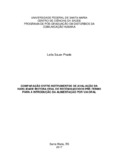| dc.creator | Prade, Leila Sauer | |
| dc.date.accessioned | 2021-03-25T13:37:02Z | |
| dc.date.available | 2021-03-25T13:37:02Z | |
| dc.date.issued | 2017-07-10 | |
| dc.identifier.uri | http://repositorio.ufsm.br/handle/1/20455 | |
| dc.description.abstract | This research aimed to compare instruments for the evaluation of oral motor skills in
preterm newborns in order to verify the readiness to start oral feeding and the oral
feeding transition through the following protocols: Preterm Oral Feeding Readiness
Scale - POFRAS; Non-Nutritive Suction Evaluation Protocol and Neonatal Oral-Motor
Assessment Scale - NOMAS. To correlate with oral feeding skill, by proficiency, rate
of milk transfer, overall transfer (OT), during the introduction of the first oral feeding,
and time of transition required for the complete transition from start to independent
oral feeding. To check which of these best instruments identifies oral feeding skill in
addition to observing the signs of stress. Seventy-one PTNB with a gestational age of
less than 34 weeks, clinically stable, who were receiving 70 ml/kg/day at the time of
the evaluation and who met the study criteria were enrolled. The PTNB were
evaluated at the first oral feeding by a single evaluator with certificate for application
of the NOMAS protocol, and after evaluation, each newborn received a classification
with or without readiness to start oral feeding, according to each protocol. PTNB with
readiness by NOMAS had higher values of proficiency and rate of milk transfer and
attained independent oral earlier. Signs of stress were lower in premature infants with
readiness. NOMAS showed higher positive and negative predictive value in relation
to the other two instruments and it was more efficacious to identify low oral feeding
skills. The POFRAS and SNN Evaluation Protocol failed to discriminate readiness to
start oral feeding. | eng |
| dc.language | por | por |
| dc.publisher | Universidade Federal de Santa Maria | por |
| dc.rights | Attribution-NonCommercial-NoDerivatives 4.0 International | * |
| dc.rights.uri | http://creativecommons.org/licenses/by-nc-nd/4.0/ | * |
| dc.subject | Recém-nascido | por |
| dc.subject | Prematuro | por |
| dc.subject | Comportamento alimentar | por |
| dc.subject | Sucção | por |
| dc.subject | Avaliação | por |
| dc.subject | Newborn | eng |
| dc.subject | Premature | eng |
| dc.subject | Feeding behavior | eng |
| dc.subject | Suction | eng |
| dc.subject | Evaluation | eng |
| dc.title | Comparação entre instrumentos de avaliação da habilidade motora oral de recém-nascidos pré-termo para a introdução da alimentação por via oral | por |
| dc.title.alternative | Comparison of instruments for the evaluation of oral motor skills of preterm newborn in the first oral feeding skills | eng |
| dc.type | Tese | por |
| dc.description.resumo | Esta pesquisa teve por objetivo comparar instrumentos de avaliação da habilidade
motora oral de recém-nascidos pré-termo a fim de verificar a prontidão para início da
alimentação oral e o tempo de transição alimentar, por meio dos seguintes
instrumentos: Preterm Oral Feeding Readiness Scale – POFRAS; Protocolo de
Avaliação da Sucção Não Nutritiva e Neonatal Oral-Motor Assessment Scale -
NOMAS; e correlacionar com a performance alimentar oral, através da proficiência,
taxa de transferência, desempenho oral total, durante a introdução da primeira
alimentação oral e tempo de transição necessários para a transição completa da
sonda para a alimentação oral. Verificar qual destes instrumentos melhor identifica a
prontidão de alimentação oral, além de observar os sinais de estresse. Para tanto,
participaram 71 recém-nascidos prematuros, com idade gestacional menor de 34
semanas, clinicamente estáveis, que estivessem recebendo 70 ml/kg/dia, no
momento da primeira alimentação por via oral avaliação e que se adequaram os
critérios do estudo. Os recém-nascidos prematuros foram avaliados, na primeira
alimentação por via oral, por uma única avaliadora com certificado para aplicação do
protocolo NOMAS, sendo que após a avaliação, cada recém-nascido recebeu uma
classificação com ou sem prontidão para iniciar a alimentação por via oral, conforme
cada um dos instrumentos. RNPT com prontidão pelo NOMAS tiveram valores
maiores de proficiência e taxa de transferência e transicionaram mais rápido. A
presença de sinais de estresse em prematuros com prontidão foi baixa. NOMAS
mostrou valor preditivo positivo e negativo maior em relação aos outros dois
protocolos, o que demonstrou ser mais eficaz para identificar baixa habilidade para
alimentação oral. O POFRAS e Protocolo de Avaliação da SNN não conseguiram
discriminar adequadamente prontidão para iniciar a alimentação por via oral. | por |
| dc.contributor.advisor1 | Weinmann, Angela Regina Maciel | |
| dc.contributor.advisor1Lattes | http://lattes.cnpq.br/9151119377173425 | por |
| dc.contributor.advisor-co1 | Keske-Soares, Marcia | |
| dc.contributor.advisor-co1Lattes | http://lattes.cnpq.br/2993790524055307 | por |
| dc.contributor.referee1 | Henn, Roseli | |
| dc.contributor.referee1Lattes | http://lattes.cnpq.br/9216370645875137 | por |
| dc.contributor.referee2 | Levy, Deborah Salle | |
| dc.contributor.referee2Lattes | http://lattes.cnpq.br/0452780908837821 | por |
| dc.contributor.referee3 | Bolzan, Geovana de Paula | |
| dc.contributor.referee3Lattes | http://lattes.cnpq.br/6911505466941984 | por |
| dc.contributor.referee4 | Haeffner, Leris Salete Bonfanti | |
| dc.contributor.referee4Lattes | http://lattes.cnpq.br/4056008693346464 | por |
| dc.creator.Lattes | http://lattes.cnpq.br/4036333034185638 | por |
| dc.publisher.country | Brasil | por |
| dc.publisher.department | Fonoaudiologia | por |
| dc.publisher.initials | UFSM | por |
| dc.publisher.program | Programa de Pós-Graduação em Distúrbios da Comunicação Humana | por |
| dc.subject.cnpq | CNPQ::CIENCIAS DA SAUDE::FONOAUDIOLOGIA | por |
| dc.publisher.unidade | Centro de Ciências da Saúde | por |



